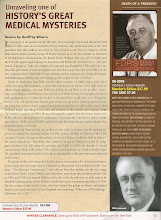
This memo is part of a group of documents recently received from the rarely viewed Walter Trohan papers at the Herbert Hoover Library in Iowa.
The author "Dwyer" is Orville "Doc" Dwyer a Chicago Tribune reporter who had been with the newspaper since the early 1920's and earned his nickname by exposing quack medicine.
The recipents were Trohan and two other high level executives at the paper W.B. "Don" Maxwell and Stanley "Little Giant" Armstrong.
Dr. Louis E. Schmidt, referred to in the document was a urologist. Mr. Maloney was also a high level Tribune exec and Col. McCormick was the publisher.
This document is important for a number of reasons:
1) It provides one of the best descriptions of Roosevelt's seizures
2) It re-confirms Francis Perkins' observation that the FDR's seizures were occurring for years.
3) It shows, for the first time, that daughter Anna had observed them and understood, to some degree, their importance.
4) It shows that the seizures were misinterpreted as "small strokes" by those outside the inner circle of doctors and staff (at the least McIntire, Bruenn, Duncan, Craig, Watson, Lahey, Paullin and probably Hopkins) and explains the basis of Dr. Wold's allegation of multiple strokes in the 1948 Look Magazine article as leaked to him by Trohan.
5) It shows that Anna was likely unaware of FDR's prostate problems. Schmidt, a urologist, would almost surely have addressed this had he been told about it.
6) And, perhaps most importantly, It underscores the implications of FDR's medical debility upon his ability to function as commander-in-chief.
Not quite as monumental, but also adding to our ever increasing understanding of this remarkable deception is this memo by Trohan himself:
It reveals what the those around FDR, including Marvin McIntyre, Jim Farley and Steve Early, knew about the Lucy Mercer affair. While the facts of 1919 appear to be somewhat incorrect, the overall implications are the same. The report from Mike Reilly about the facts of April 12, 1945 are quite accurate and the document clearly shows that the Tribune sat on the Lucy Rutherfurd story for the 17 years until Jonathan Daniels made it public.
There is perhaps even more yet to be found in Iowa!
(ps. This post was written in October. I have since visited the Hoover libray and spent a most rewarding day researching the papers of Walter Trohan and Westbrook Pegler. In fact, my conversations with the great Roosevelt biographer Geoffrey Ward lead me to believe that Geoff now believes that the version of the story about Lucy in the Dwyer letter is actually correct. Of similar importance, this document also reveals that the Trib and Colonel McCormick sat on the Lucy story for 17 years until it was first publicly acknowleged in an article by Jonathan Daniels).



























